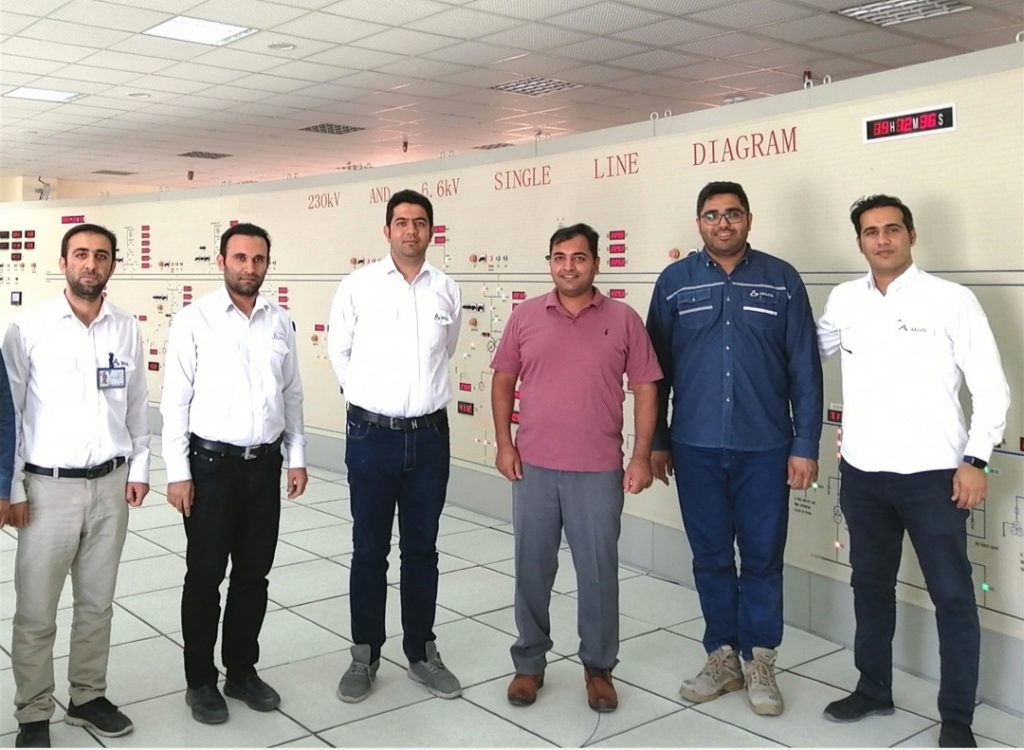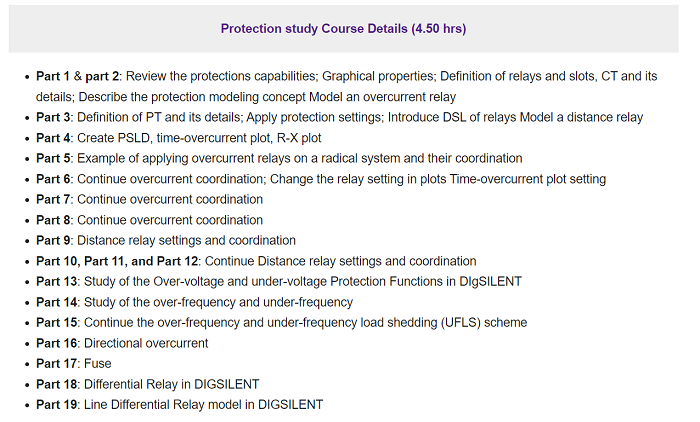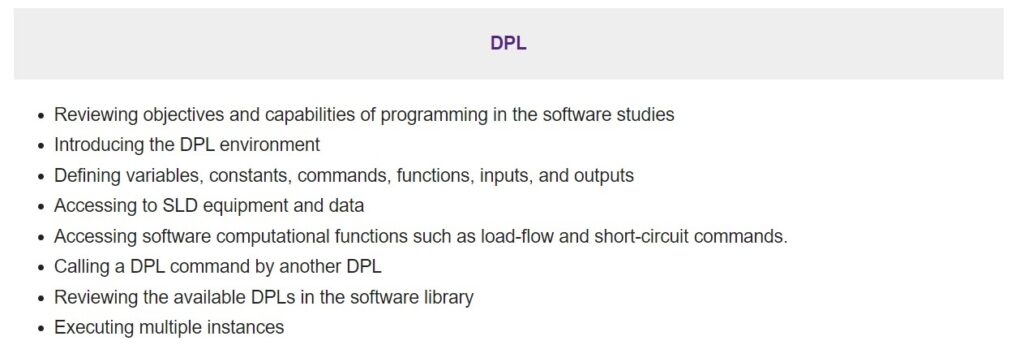

DIgSILENT Power Factory software is one of the most powerful software in network analysis that will use in all the areas of generation, transmission, and distribution. DIgSILENT stands for DIgital SImuLation and Electrical NeTwork calculation program.
The purpose of this course:
Acquaint engineers with the process of analyzing power systems to carry out research, industrial and other projects. Using this software, almost any power network can be modeled and calculations such as load flow, short circuit, transient analysis, optimal capacitor placement, cable size optimization, etc. can be provided in the form of various functions. In addition, other features such as programming in DPL language and defining DSL models provide the flexibility for the user to perform the desired analysis on the power system and the equipment that is not available in the software library.
Main Training Materials:
Part A (2 hrs, 50 min)
- P 01: Course Contents and details
- P 02: Introduction of DIgSILENT
- P 03: Comparision of common power system study software
- P 04: Brief overview of DIgSILENT environment
- P 05: DIgSILENT menu
- P 06: DIgSILENT menu
- P 07: Study tools in DIgSILENT
- P 08: Creating a simple 3-bus system in DIgSILENT
- P 09: Line/cable modeling and parameters
- P 10: Generator modeling and parameters
- P 11: Transformer modeling and parameters
- P 12: Loads and busbar modeling and parameters
- P 13 -15: DIgSILENT Graphics, tools, and applications
- P 16: Elements in DIgSILENT
- P 17: Different scenarios, case studies, Variations
- P 18: Different scenarios, case studies, Variations
- P 19: Equipment modeling; External Grid
- P 20: Load
- P 21: Breaker/switch
- P 22: Synchronous generator
- P 23: Transformer
- P 24: Line
- P 25: Cable and Shunt/filter C or capacitor bank
- P 26: Power flow study; Study setting
- P 27: Power flow study; Different output and reporting
- P 28: N-1 study; Study setting
- P 29: N-1 study; Different output and reporting
- P 30: Short-circuit study; Study setting
- P 31: Short-circuit study; Different output and reporting
- P 32: Transient study; Defining different events; Study setting
- P 33: Transient study; Study setting; Different output and reporting



new parts will be added soon!
To Download: https://elec-engg.com/product/digsilent-training/
- saeed61850@gmail.com / info@elec-engg.com
- WhatsApp: +989129613659
Supplementary files:
- DIgSilent PowerFactory 15 User Manual
- Load Flow Analysis in DIgSILENT PowerFactory
- Load Flow and Dynamic Simulation with the Palau Grid
- Load Flow and Short Circuit Calculation(Training Material)
- Load flow Calculations(Training Course)
- DIgSILENT Programming Language(DPL)
- DPL Tutorial
- Distance Protection Tutorial
- Detailed Modelling of HV Single-Core Cale Systems
- Compatibility Issues in Time Domain Simulations with DIgSILENT PowerFactory and SIEMENS PSSE
- Cable Modelling Tutorial
- Relay Modelling
- DPL Function Reference
- Dynamic Modelling Tutorial
- Advanced Smart Grid Functionalities Based on PowerFactory
- Short-Circuit Calculations(Training Course)
- Dynamic Wind Turbine Models in Power System Simulation tool DIgSILENT
- Grid Connection of WindFarms
- Implementation of the Model of a Solar Inverter
- Improving the Photovoltaic Model in PowerFactory
- Exercises for the Power System Stability
- Grid Compatibility of Wind Generators with Hydro-Dynamically Controlled Gearbox with German Grid Codes
- DIgSILENT PowerFactory Model Documentation IEC 61400-27-1 WTG Models
- Multicore Simulation of Power System Transients
- Over-Current Protection Tutorial
- Power System Stability on Island Networks
- Power Systems Electromagnetic Transients Simulation
- PowerFactory Applications for Power System Analysis(Springer)
- Python Advanced Tutorial
- Synchronous Generator(Training Course)
- Transients in Power Systems by Lou van der Sluis
- digsilent power factory 15 download
- DIgSILENT Relay Library
Equipment modeling
- Modeling of the external grid
- Modeling of transmission lines in various methods
- Modeling of the bus, switch, and circuit breaker
- Modeling of different types of transformers
- Modeling of the induction motor and generator
- Modeling of the synchronous motor and generator
- Modeling of the capacitive banks and reactors in series or parallel connection
- Introducing renewable energy sources models: Solar and Wind
Load-flow study
- Review the concept of load-flow study and application
- Describe load-flow calculation methods and settings
- Discussing the process of equations solve
- Report the results of the study
- Specifying the special outputs
- Describe graphic considerations
- Check the errors and equations divergence
- Execute multiple instances
- Investigate how to correct network problems like voltage drop, lines, and transformers overload
Single contingency (N-1) study
- Review the concept of single contingency study and application
- Create different contingency definitions and settings
- determine and check the study results
- Describe graphic considerations
- Execute multiple instances
Short-circuit study
- Review the concept and application of short-circuit studies
- Overview of the IEC-60909 standard
- Define different types of the short-circuit studies
- Discus short-circuit settings
- Describe graphic considerations
- Investigate the effect of earthing type on the short-circuit study
- Execute multiple instances
Short-circuit study
- Review the concept and application of short-circuit studies
- Overview of the IEC-60909 standard
- Define different types of the short-circuit studies
- Discuss short-circuit settings
- Describe graphic considerations
- Investigate the effect of earthing type on the short-circuit study
- Execute multiple instances
Transient stability study
- Review the concepts of transient stability
- Overview of the theory of electromagnetic and electromechanical transient studies
- Define AVR, Governor, and PSS for synchronous generators and other dynamic models of equipment
- Define online tap changer (OLTC)
- Introduction of DSL
- Define different types of events
- Determine the appropriate parameters to create the output
- Draw different types of curves and outputs
- Review the available dynamic models in the software library
- Execute multiple samples and calculate CCT
DIGSILENT Training Course Contents – Advanced
Voltage stability study and capacitor placement
- Review the concepts of voltage stability and assessment methods
- Draw P-V and Q-V curves
- Execute multiple instances
Power quality and harmonics
- Review and importance of the power quality
- Modeling harmonic sources
- Harmonic power flow
Load modeling
- Review and importance of the load modeling
- Introduction to the various load models
- Apply the load model in the software
- Execute multiple instances
Modal analysis
- Review the modal analysis of the concepts
- perform modal analysis and its settings
- Check the controllability and visibility of the system
- Graphic considerations
- Execute multiple instances
- Introduce methods to eliminate dynamic instability
Protection study
- Review the protection concepts
- Definition of different relays types
- Definition of CT and PT
- Apply protection settings
- Check the relay’s static performance
- Check the relay’s dynamic performance
- Check the protective coordination
- Drawing the relays curves
- Describing graphic considerations
- Reviewing the available relay models in the software library
- Executing multiple instances
Reliability study
- Reviewing the objectives of reliability studies and important indicators of such as SAIFI, SAIDI
- Applying inputs and extracting reliability outputs
- Checking the settings for conducting a reliability study
- Executing multiple instances and changing the network restructure to improve the reliability indicators
DPL Introducing
- Reviewing objectives and capabilities of programming in the software studies
- Introducing the DPL environment
- Defining variables, constants, commands, functions, inputs, and outputs
- Accessing to SLD equipment and data
- Accessing software computational functions such as load-flow and short-circuit commands.
- Calling a DPL command by another DPL
- Reviewing the available DPLs in the software library
- Executing multiple instances
Our available courses:
- IEC 61850 Configurator Training (4 Hrs)
- DIGSI 4 Offline Video Training (3 Hrs)
- DIGSI 5 Offline Video Training (7 Hrs)
- ETAP VIDEO Training (5.5)
- PSCAD Video Training (4 Hrs)
- PCM 600 Video Training (4 Hrs)
- MiCOM Relays Training Package (4 Hrs)
- Testing and Commissioning of Protective Relays
- Generator Protection Training Package
- Busbar protection training package